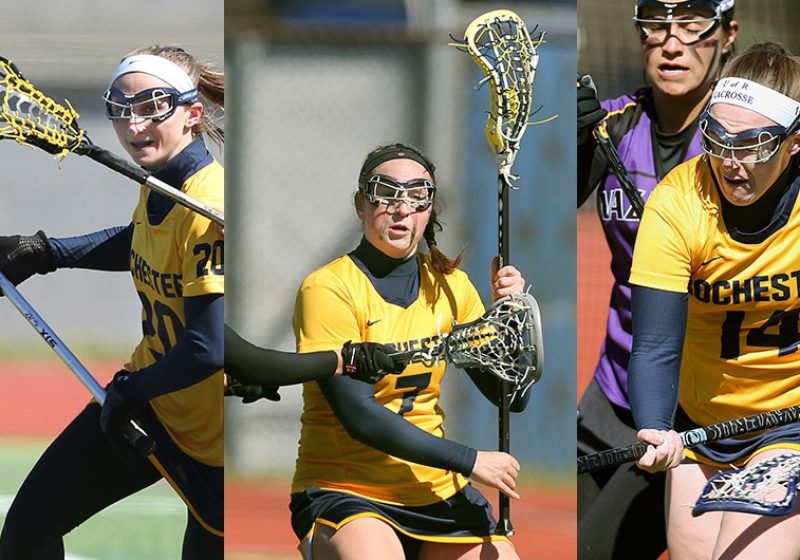Nine games into the season, UR Women’s Lacrosse (URWL) is off to an auspicious start, racking up a 7–2 record and outscoring opponents by average of 5.78 goals per contest. The team’s early success owes to solid contributions from many players.
Conley Ernst’s performance has been among the best at her position this season. The sophomore goalie is ranked 10th in the nation in goals-against-average, allowing just 5.37 per game. Her save percentage of .560 is similarly impressive, ranking her 13th.
Though she is highly effective at getting saves when the ball is sent her way, she is actually ranked 195th in saves per game, which says a lot about the ability of the rest of the defense to prevent shots on goal in the first place.
The ‘Jackets certainly seem to be dominating possession in games—they outshoot opponents 27–16 on average, and have the edge in the percentage of those shots that are on goal, 75.4–68.8.
That Ernst is actually ranked higher in goals-against-average than save percentage, despite a low amount of shots faced, leads one to believe that strong defensive and goalie play are highly correlated (that is, all else removed in either category, a team that excels in one would do so in the other as well).
In fact, one strength on offense (aside from maintaining pressure in the opponent zone) appears to be playing an appreciable role in the team’s goal prevention. URWL is only turning the ball over 12.43 times per game, good for 13th in the nation. Turnover prevention is key in that it both allows for more offensive opportunities and prevents fastbreak opportunities for the other team.
As a whole, the offense has been serviceable, ranking in the middle of the pack at 143rd with 10.71 goals per game. Senior midfielder Jamie Wallisch has driven the unit, leading the team with 26 goals and 12 assists. She has been entrusted with a large portion of the team’s possessions, taking 27 more shots than her next teammate and leading the team in most counting statistics.
Junior midfielder Mady Levy has been the team’s next-most-frequent scorer, average three points per game (behind Wallisch’s 4.2). She’s missed four games, giving her lower totals, but she’s been highly efficient when active—she’s accrued her 13 goals on just 28 shots, giving her a shooting percentage of .464, well above the team average of .402. Freshman midfielder Marina Kern is the team leader in this figure among those who have taken at least 10 shots, with a .529 shooting percentage.
When offense and defense are combined, the team has maintained a strong edge over opponents—one that may actually be stronger than its already impressive record suggests. On the surface level, it ranks 39th in scoring margin and 49th in win percentage.
When one considers that the team owes more of their success to defense, then this gap is actually a bit larger. A team that outscores its opponents 11–5 on average should be expected to win a higher percentage of its games than a team that outscores its opponents 15–9, for example. This is because the first team holds a better ratio of scoring (2.2 to 1.7), and the state of games will be less volatile.
Pythagorean expectation is a formula designed to convert this ratio of scoring to an expected winning percentage. It uses an exponent that differs based on the sports. A low-scoring sport such as baseball uses an exponent around two (hence the name pythagorean), while a high-scoring game such as basketball typically uses an exponent greater than 10.
A lower exponent means that a smaller change in the ratio will have a higher effect on the team’s expected winning percentage, and vice versa.
For the purposes of URWL, we used an exponent derived from Division I Men’s Lacrosse (slightly modified to account for how many goals are scored on both sides in a URWL game using a method called Pythagenpat).

The team has tripled its winning percentage from last year, and their stats suggest that they may actually be better than that.
The associated graph shows that the team’s expected winning percentage this year is close to .900, compared to their actual .778 percentage. Often when scoring margin or ratio is considered, blowouts tend to distort things considerably.
A way of dampening this is to take the pythagorean winning percentage of the team for each individual game and take the season average. The result of this calculation gives a .723 expected winning percentage, lower than its actual performance.
Regardless of which of these figures is the most “correct” as to to the team’s prowess, it’s leagues of ahead of where it was in years past. The team won exactly two games in four consecutive seasons from 2010-13. After improving to a middle-of-the-road team in 2014-15, the team regressed back to a .250 winning percentage last season.
This season, thanks to a promising slate of freshmen and major improvements by returning players, the results and underlying statistics agree that URWL has made a huge jump and is now a force to be reckoned with.





